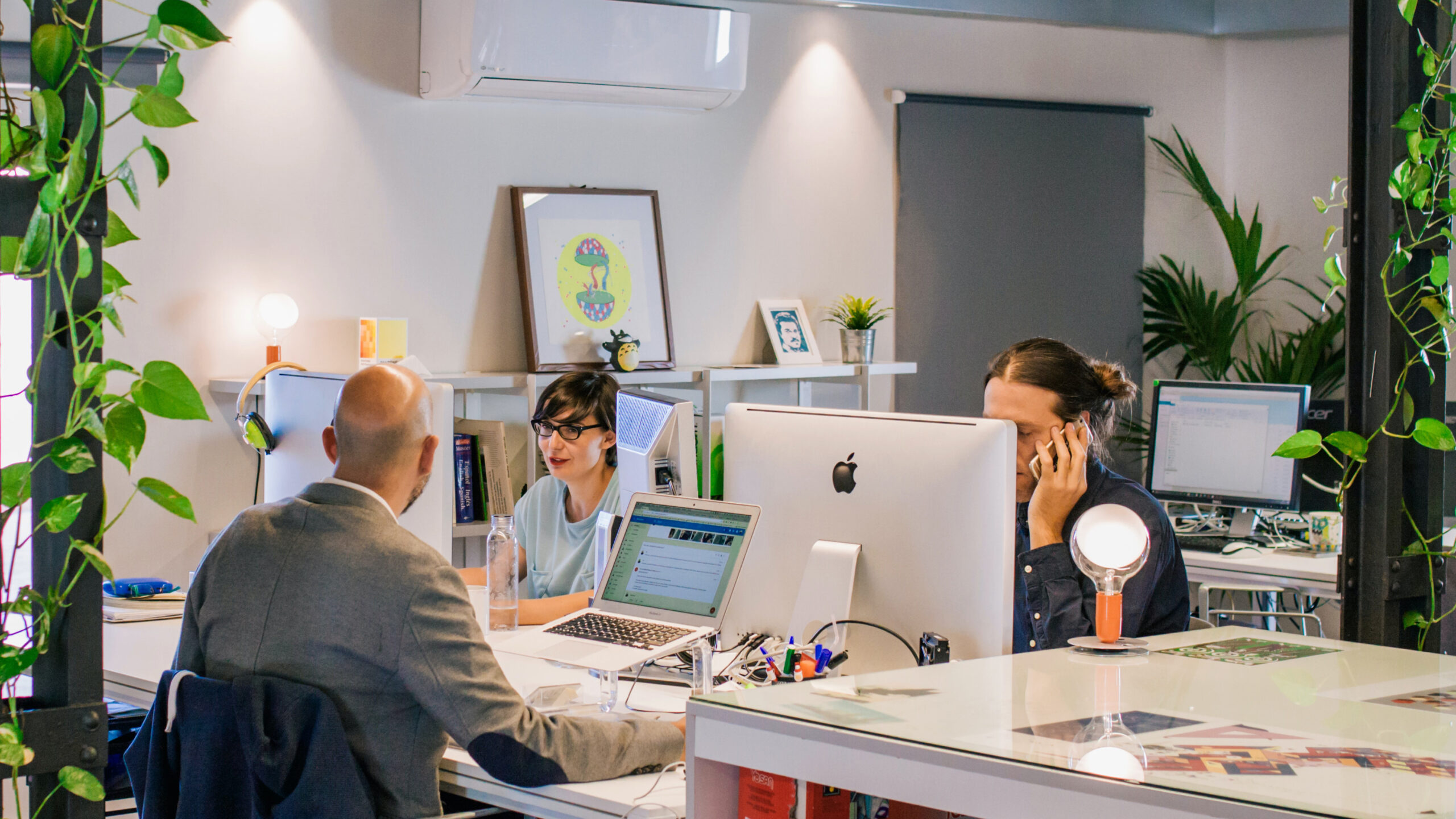The space in which you work can affect your mood, your productivity, your creativity, your comfort, and your health, so it is really important that you get it right. Read on to see our top tips on creating a workspace that you want to be in.
Biophilic Design
Biophilia is our predisposition as humans to connect with the natural world. Being close to nature is thought to have lots of positive benefits, consultancy firm Terrapin Bright Green who specialise in providing their clients with Biophilic design-led environments writes – “Biophilic design can reduce stress, improve cognitive function and creativity, improve our well-being and expedite healing.”
So, what does this mean for you in your office space? It really can be as simple as having some house plants, according to research carried out by a group of universities ‘Green’ offices with plants make staff happier and more productive than ‘lean’ designs stripped of greenery.
They go as far as to suggest that plants in the office can lead to a 15% boost in productivity and for those of you that are not green-fingered, there are plenty of low-maintenance options out there, just by popping to your local garden centre.
Light
Another area of Biophilic design is natural light. When setting up your office consider where the windows are. Experiencing natural light throughout the working day, as well as having access to outdoor views, which encourages short breaks from the screen are known to have health benefits and promote a sense of wellbeing. In fact, the Harvard Business Review highlighted research carried out by Professor Dr. Alan Hedge, which revealed workers in daylight office environments reported a 51% drop in the incidence of eyestrain, a 63% drop in the incidence of headaches, and a 56% reduction in drowsiness. Natural light helps to counteract screen and phone lighting and helps to keep the bodies biorhythm in line, this helps support a healthy sleep pattern, balances hormone levels and body temperature.
Whilst it is clear access to natural light is beneficial, this may not be possible in your office and even when there is some daylight, depending on the time of year, this will not always provide the right amount of light and could even cause glare on your screen. In these instances, other solutions such as daylight lamps, which imitate natural light are a good option. These can be placed on your desk and positioned to provide focused lighting. You may also need to consider an anti-glare shield or blinds for any unwanted light; either from windows or overhead artificial lights.

Sound
Here’s one for the open office users or those in a shared office and once again it comes down to our nature as humans. We are predisposed to be attracted to speech, so try as you might to ignore your colleague who is on a very long and loud phone call, it is impossible to do so and this is where we again come back to nature. When the sound of natural spring water was played, The Finish Institute of Occupational Health found it masked the sound of distracting speech, so why not check out BBC Sounds Mindful Mix or one of the many choices on Audible or Apple Music. If the sounds of nature are not for you then think about using baffle boards or noise-canceling headsets to help reduce distracting noises.
Thermal comfort
Thermal comfort or lack of can have a profound effect on a person’s productivity and efficiency. If you are either too hot or too cold your concentration and focus are likely to be affected and this is when mistakes can be made.
Thermal comfort in the workplace is measured by how many employees report discomfort. A thermal environment is not just about the room temperature but also takes into account the type of work being done, so, for example, an office, where the work is sedentary will require a higher temperature than a factory where the workforce is more physically active. According to the HSE, the correct thermal environment is said to be achieved when it satisfies the majority of the employees working within it. Your thermal comfort will also be impacted by ventilation. When setting up your workstation be mindful of ventilation sources, you do not want to be sat in a draught, not only is this distracting and uncomfortable it can cause the muscles to contract and cause stiffness and aching to the joints. If ventilation is coming from an air conditioning unit the direction and speed of airflow can be controlled mechanically, if a draught is coming from gaps in windows or doors these will need to be sealed up.
Equipment
Once you have created the right working environment you also need to consider your workstation equipment, as this can have a direct impact on your comfort and health. This includes your desk, chair, and monitor. See our previous posts on workstation and chair setup for more details. Once your chair and desk are set up correctly you also need to consider the input devices you choose. You might find a standard keyboard and mouse are sufficient for your needs, however, if you experience any discomfort in your hands and fingers, or your arm and shoulder, or in your thoracic spine from typing or mouse use, you may want to consider a specialist ergonomic keyboard and mouse.
If you suffer from shoulder pain, a compact keyboard with a smaller footprint will allow you to bring the mouse in closer to your body, reducing the stretch on your shoulder. If you find gripping a standard mouse is painful, a vertical mouse that can be held with the hand in a hand shake-like position may improve your symptoms. Similarly, you may prefer a flat mouse, more like a mouse pad on a laptop, this can be placed centrally, again reducing stretch on the arm. There is a myriad of choices out there and it is important to do your research and choose devices that are right for you.
Big Ideas
Whilst there are some big ideas discussed here, it only takes small changes to create a workspace that creates a sense of wellbeing and comfort and provides an environment in which you can be at your best.
And of course, if you need any advice setting up your workspace and purchasing the right equipment speak to Access2Comfort about arranging a workstation assessment for personalised recommendations. Get in touch on 01603 839299 or drop us a line.


Recent Comments